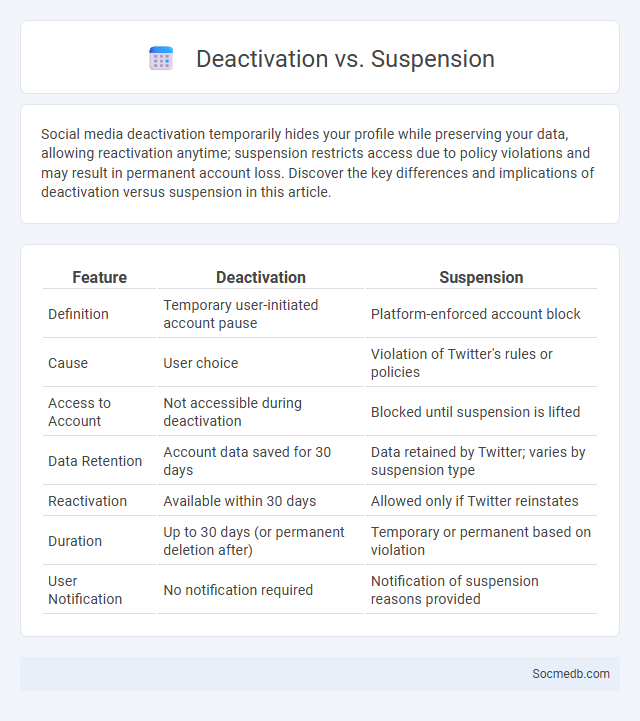
Photo illustration: Deactivation vs Suspension
Social media deactivation temporarily hides your profile while preserving your data, allowing reactivation anytime; suspension restricts access due to policy violations and may result in permanent account loss. Discover the key differences and implications of deactivation versus suspension in this article.
Table of Comparison
| Feature | Deactivation | Suspension |
|---|---|---|
| Definition | Temporary user-initiated account pause | Platform-enforced account block |
| Cause | User choice | Violation of Twitter's rules or policies |
| Access to Account | Not accessible during deactivation | Blocked until suspension is lifted |
| Data Retention | Account data saved for 30 days | Data retained by Twitter; varies by suspension type |
| Reactivation | Available within 30 days | Allowed only if Twitter reinstates |
| Duration | Up to 30 days (or permanent deletion after) | Temporary or permanent based on violation |
| User Notification | No notification required | Notification of suspension reasons provided |
Understanding Account Deactivation
Account deactivation on social media temporarily disables your profile, hiding your content and preventing others from finding you or interacting with your account. You retain access to reactivate your account and restore your data at any time, making it a reversible step compared to permanent deletion. Understanding account deactivation helps you manage your online presence without losing valuable connections or information.
What is Account Suspension?
Account suspension on social media occurs when a platform temporarily or permanently restricts your access due to violations of community guidelines or terms of service. This action prevents you from posting, commenting, or interacting with others, effectively disabling your account's functionality. Understanding the reasons behind account suspension helps you take corrective steps to restore your online presence and maintain compliance.
Key Differences Between Deactivation and Suspension
Social media deactivation temporarily hides your profile and content from others without deleting your account, allowing you to reactivate and restore all data later. Suspension usually results from violations of platform policies, restricting access for a set period or until issues are resolved, often with limited possibility for immediate reactivation. Understanding these key differences helps you make informed decisions about managing your online presence and adhering to platform guidelines.
Reasons for Account Deactivation
Account deactivation on social media often stems from concerns over privacy breaches, excessive screen time, and negative psychological effects like anxiety and depression. Users may also deactivate accounts to escape online harassment, reduce digital distractions, or protect personal information from unauthorized access. Increasing awareness of data misuse and the desire for a digital detox contribute significantly to the trend of account deactivation.
Common Causes of Account Suspension
Social media account suspensions commonly result from violations such as spamming, posting inappropriate content, and engaging in harassment or hate speech. Platforms enforce policies against impersonation, fake accounts, and the spread of misinformation to maintain community standards. Repeated breaches or severe offenses can trigger temporary or permanent suspension, impacting users' ability to access their profiles and content.
Impact of Deactivation on User Data
Deactivating your social media account typically suspends your profile visibility but retains most of your data on the platform's servers, allowing for potential reactivation and data recovery. User content such as posts, messages, and personal information often remain stored and may still be accessible to administrators or through backups. Understanding platform-specific policies is crucial since data retention periods and the extent of data preservation vary widely across social networks.
Suspension: Temporary or Permanent?
Social media account suspension can be either temporary or permanent, depending on the severity of the violation of platform policies. Temporary suspensions typically last from a few hours to 30 days, serving as warnings for minor infractions such as posting inappropriate content or spamming. Permanent bans result from repeated offenses or severe breaches like hate speech, harassment, or illegal activities, leading to irreversible loss of access to the account.
How to Reactivate a Deactivated Account
To reactivate a deactivated social media account, log in using your original username and password on the platform's official website or app. Most platforms allow reactivation within a specific timeframe, typically 30 to 90 days, after which accounts may be permanently deleted. Ensure that you follow any additional verification steps required, such as email confirmation or two-factor authentication, to regain full access.
Steps to Appeal a Suspended Account
To appeal a suspended social media account, begin by carefully reviewing the platform's community guidelines and terms of service violations associated with the suspension. Next, locate the official appeal form or support contact on the social media platform's help center, ensuring you provide necessary details such as account username, suspension reason, and a clear, concise explanation or evidence supporting your case. Monitor the platform's response times, which can vary from a few days to several weeks, and be prepared to submit follow-up inquiries if no response is received within the expected timeframe.
Choosing the Right Action: Deactivation vs. Suspension
Choosing between social media deactivation and suspension depends on the user's intent and platform policies. Deactivation typically allows temporary account invisibility with the option to reactivate, preserving data and connections. Suspension, often enforced by the platform, restricts access due to policy violations and may result in permanent account loss.
 socmedb.com
socmedb.com